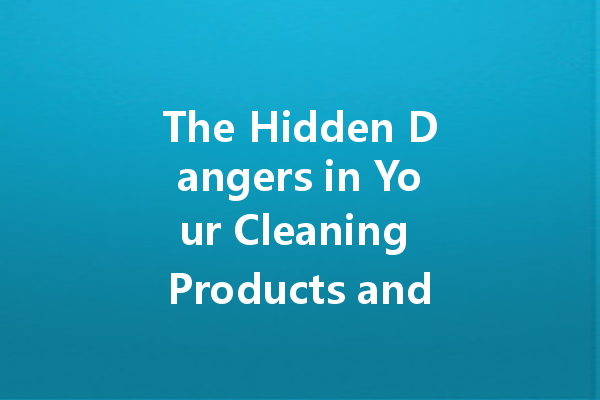Cleaning products are essential in maintaining a hygienic home or workspace, but many consumers are unaware of the potential dangers lurking in their favorite household cleaners. From hazardous chemicals to environmental impact, understanding these risks is crucial for safe cleaning practices. This article explores the hidden dangers associated with common cleaning products and provides practical tips on how to avoid them.
Understanding the Chemicals in Your Cleaners
Common Toxic Ingredients
Many cleaning products contain hazardous substances that can adversely affect health and the environment. Common toxic ingredients include:
The Impact on Health
Exposure to toxic chemicals in cleaning products can lead to various short
Environmental Considerations
The Effect on Air Quality
Using conventional cleaners contributes to indoor air pollution, significantly impacting overall air quality. Studies have shown that the vapors released by cleaning products can linger in the air long after cleaning, leading to prolonged exposure for occupants. This can exacerbate allergies and respiratory conditions.
Water Pollution
Many commercial cleaning products contain phosphates and other harmful substances that can enter water systems, contributing to pollution. These chemicals can disrupt ecosystems and adversely affect fish and wildlife.

How to Avoid Hidden Dangers
Choose Natural or Eco-Friendly Products
One of the best ways to mitigate the risks associated with conventional cleaning products is to opt for natural or eco-friendly alternatives. These products often contain plant-based ingredients that are safer for both human health and the environment. Look for certifications or labels indicating eco-friendliness, such as USDA Organic or Green Seal.
DIY Cleaning Solutions
For those who want to maintain control over what goes into their cleaning products, making homemade cleaners is an excellent option. Common DIY ingredients include:
Read Labels Carefully
Always read product labels before purchase. Familiarize yourself with hazardous ingredients and avoid products containing parabens, phthalates, and other toxic substances. Additionally, be cautious of misleading marketing claims such as “natural” or “green” without the proper certifications.
Safe Cleaning Practices
Ventilation is Key
Ensure proper ventilation while using cleaning products to minimize exposure to harmful fumes. Open windows and use exhaust fans when cleaning, especially in poorly ventilated areas like bathrooms and kitchens.
Store Products Safely
Keep cleaning products out of reach of children and pets. Use child-proof locks and store products in high cabinets to prevent accidental exposure. Ensure your storage area is well-ventilated to prevent buildup of harmful fumes.
Conclusion
Being aware of the hidden dangers in cleaning products is essential for protecting both your health and the environment. By choosing safer alternatives, making your own cleaning solutions, and practicing safe cleaning habits, you can create a cleaner, healthier home without compromising on effectiveness. Stay informed and make conscious choices to ensure that your cleaning routine contributes positively to your well-being and the planet.
